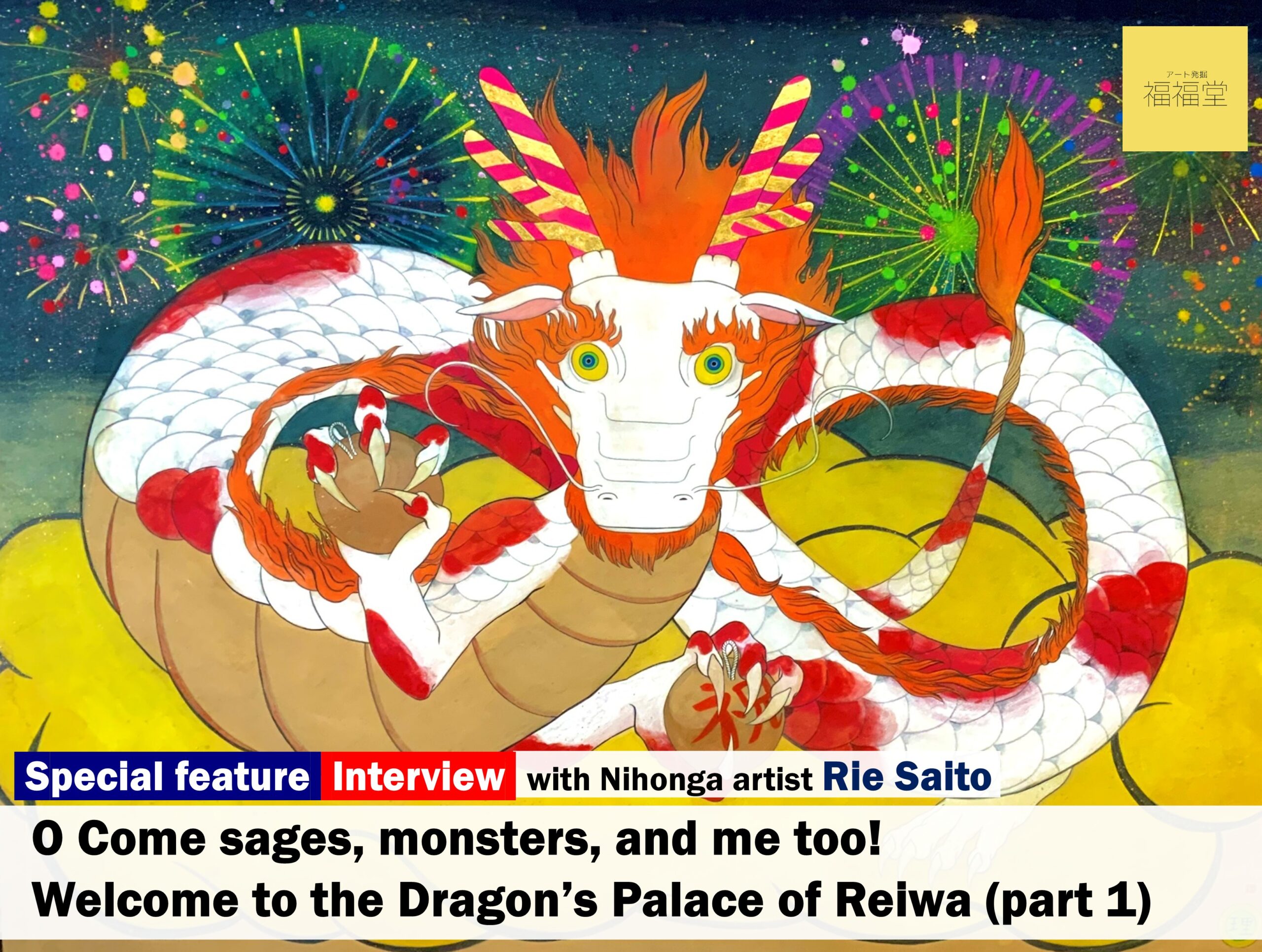
Interview with Nihonga artist, Rie Saito. Please enjoy reading this interview by the FFD editorial team!
Interview with Nihonga artist Rie Saito (part 1)
I won’t listen to my teacher; I’m painting from my heart!
Thank you for taking the time for this interview today. What was your first encounter with drawings?
Thank you for having me. I guess my first time would have been at the age of three, tagging along with my mother, going to an art class and copying her drawing.
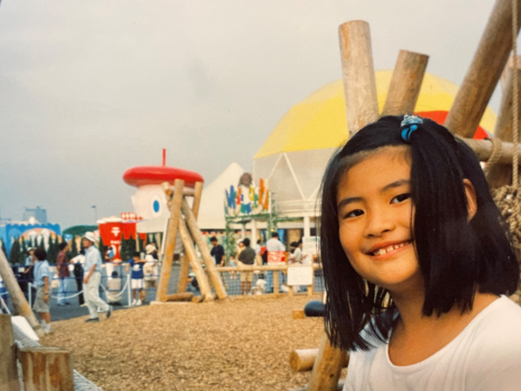
What kinds of pictures were you drawing?
I’m told that my drawings were very childlike, such as drawings of an onigiri and chestnut smiling and holding hands. However, the colors I chose tended to be dark, concerning my parents and art teacher.

After I started elementary school, my paintings gradually became less dark. I think this was because I drew more pictures at home with my mother. Looking back, I used to like the animation Gegege-no-Kitaro, and Kitaro was my first crush. I appreciated how Kitaro never got angry at Nezumi Otoko, no matter how terrible Nezumi Otoko was to him.
You liked Kitaro’s bigheartedness.
I guess so. I started learning how to paint with watercolors in 4th grade through the art class my mother was taking. She mostly worked with landscape motifs and still-life paintings. Her teacher also often traveled, and my mother would hand me photos of Italy, France, and Monaco and tell me to paint them. I refused, telling her, “I don’t know where these places are and I don’t want to paint them!”, and instead painted sunflowers and things from my imagination.
You knew what you wanted and weren’t shy about it.
In hindsight, I probably had a rather rebellious streak. If someone told me, “Draw this”, I would refuse to draw it… I’m sure I gave the teachers a hard time ? they always said, “she won’t do what I tell her”. As I watched my mother continue to work hard at her drawings, it made me want to draw the same thing and I ended up staying in the class until I was in 8th grade.

Artists are like unicorns
In 8th grade, unsure of which direction to pursue my education in high school, I thought of studying art, knowing that “I enjoyed drawing”. I didn’t have any aspirations to become an artist yet at that point, because in my mind, I thought artists were like unicorns. Becoming an artist just didn’t feel real to me. For my career path, I hoped that I would have a profession aside from being an artist, paint in my spare time, and ideally one day be recognized to make it as an artist.
I like how you refer to being an artist as being like a unicorn.
Finding horses with horns doesn’t seem so far-fetched, and yet, they don’t exist. That’s what becoming an artist felt like for me. I stopped going to the art class in 8th grade and instead started attending a prep school for high school entrance exams. I had vague aspirations of getting a job in the design field after graduating from a college of arts, but I wasn’t thinking about becoming an ‘artist’ yet at that stage. Then one day, a girl at the prep school told me about a relative of hers who was an artist, and I discovered that there really are people who make a living with their art.
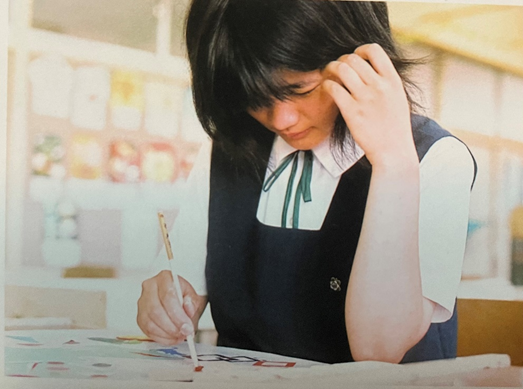
Brilliant Nihonga paintings
I went back to the teacher from my earlier art classes to discuss my interest in pursuing a future in the art field. They recommended Tokyo Geidai (Tokyo University of the Arts. Founded in 1887, it’s Japan’s only national comprehensive university of the arts, and the best fine arts university in Japan), and more specifically, to study at the department of design. I then looked for a local high school with a strong track record of students entering Tokyo Geidai and took the entrance exam.
That’s how your path to an arts education started.
Yes. Once I started high school, I went to see the Nitten exhibition at the Tokyo Metropolitan Art Museum and discovered exquisite paintings that, to me, sparkled and shone like gems. I was amazed and confused by these paintings: “these colors resemble watercolors, but these aren’t watercolor paintings, neither are they oil paintings. What are these? The caption says Nihonga. Nihonga – this is Japan, so aren’t all drawings made in Japan technically Nihonga?”. I was fascinated with the Nihonga genre and started learning more about it: traditional techniques that use mineral pigments, dried pigments, sumi ink, and glue. Coming from a place where my knowledge consisted of painting with crayons and watercolor paint coming out of tubes, this was a revelation.
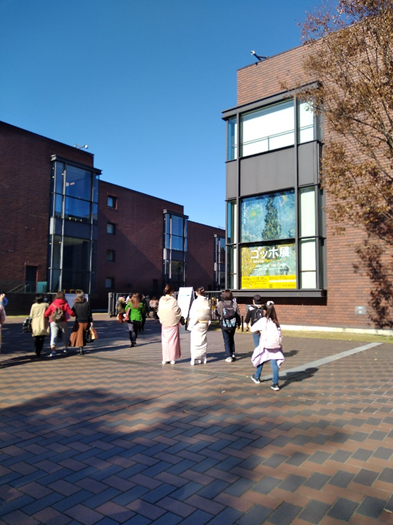
6 years of taking entrance exams to get into college
In my senior year of high school, I took the entrance exam for Tokyo Geidai, and every year after for 6 years. It’s not rare for aspiring students to take the entrance exam multiple years to get into Tokyo Geidai, but spending six years studying and drawing every day to pass the entrance exam was a painstaking process.

Getting into a university of fine arts is incredibly difficult for many students
Thinking back, I may have been a little single-minded about getting into Tokyo Geidai to become an artist. During the 6 years preparing to pass the exam, I worked part-time jobs to pay for prep school. I suffered from anxiety and struggled with my fear of small spaces and was sometimes unable to get on the train. On my seventh attempt, I got to the point where I thought that I might never be accepted. Nevertheless, I knew I wanted to pursue studies in fine arts, so I decided to enroll in the correspondence course at Kyoto Geidai instead.
On discovering that artists really do exist
What studies did you pursue in Kyoto Geidai?
My classmates ranged from those in their teens to those in their seventies. They were eagerly studying art, and seeing that gradually helped improve my mental health. I studied a variety of techniques in great detail, and also learned many other things that interested me: curating (involving planning and organizing exhibitions, doing research in specialized areas), branding, marketing, and how to make a living as an artist. Unfortunately, there were no courses offered on ‘how to become a painter’ or ‘how to successfully sell your paintings’.
What did you do?
I decided to do my own research using the internet. I found a western-style art management course GUAMS (Gallery Uehara Art Management Studio; instructor Go Yokura; sponsor Fukufukudo; the course that ran until 2020 to foster professional artists).
GUAMS was still active then.
I went to see an art fair at Matsuya Ginza, where the young graduates from GUAMS were showing their work. It was the first time I saw artists around my age pricing their art to sell at an exhibition, and that’s when it hit me that my dream wasn’t to just have a job in the art industry, but to become a painter. I was 24 years old.
Is that when you joined GUAMS?
I gradually began to get a real sense of what an ‘artist’ was. It’s as if I’d been told all my life that the Tsuchinoko (a mythical creature in Japanese folklore) didn’t exist, and then all of a sudden was shown proof that it does exist. After attending the practical course at GUAMS, I spent a year submitting my art to public exhibitions. When I was 28, a GUAMS instructor and fine point pen artist invited me to participate in a special exhibition at a department store. From there, I gradually gained more opportunities to display my art in department store exhibitions around Japan and got to know customers who welcomed me.

Rie Saito, Artist Bio
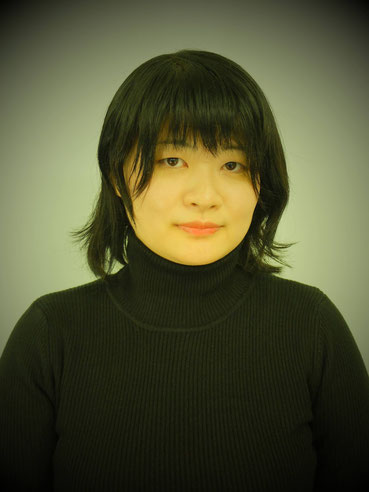
1990 Born in Kita-ku, Tokyo
2014 Entered Kyoto University of the Arts, Faculty of the Arts Correspondence Education
2016 The 33rd FUKUI Thumbhole Art Exhibition, Honorable mention
The 11th Tsuki-no-Art Exhibition, Keihanna Commemorative Park, Tsuki-no-Niwa Gallery, Honorable mention
2017 Tokyu Den-en Toshi Line 27 Station Exhibition ~Tale of 27 train lines~, Tokyu Department Store, Tama Plaza
East Asia Culture City 2017 Kyoto Partnership Program, Asian Corridor, Contemporary Art Department Special Cooperative Projects, Kyoto Student Art Auction, Honorable mention
The 43rd Contemporary Children’s Art Exhibition, Tokyo Metropolitan Art Museum, Honorable mention
2018 Asia Design Art Exhibition Phnom Penh, Royal University of Phnom Penh Kizuna Hall
KENZAN, Tokyo Metropolitan Theatre
The 44th Contemporary Children’s Art Exhibition, Tokyo Metropolitan Art Museum, Rookie of the Year award
The 6th MVW Exhibition, Fukuya Hatchobori Main Building
2019 Gold and Silver Leaf Exhibition, Hanshin Umeda Main Building
New Green Art Fair 5 Continents 5 Colors, Hilltopia Art Square
Art Sekigahara ~Osaka Summer Campaign~ , Hanshin Umeda Main Building
The 45th Contemporary Children’s Art Exhibition, Recommended society member, Tokyo Metropolitan Art Museum,
2020 Graduated from Kyoto University of the Arts, Faculty of the Arts, with a major in Nihonga
Eleven Girls Art Collection Exhibition, Hanshin Umeda Main Building
Eleven Girls Art Collection Exhibition, Fukuya Hatchobori Main Building
The 46th Contemporary Children’s Art Exhibition, Recommended society member, Tokyo Metropolitan Art Museum
2021 Grand EGC, Hilltopia Art Square
NEXT GENERATIONS Exhibition, Fukuya Hiroshima Station Store, Hiroshima
The 47th Contemporary Children’s Art Exhibition, Recommended society member, Tokyo Metropolitan Art Museum
2022 Tiger and Cat Exhibition, Isetan Urawa Store
Eleven Girls Art Collection Exhibition, Fukuya Hatchobori Main Building
Grand EGC, Hanshin Umeda Main Building
Description of Rie Saito’s work “Dosu-Koi”
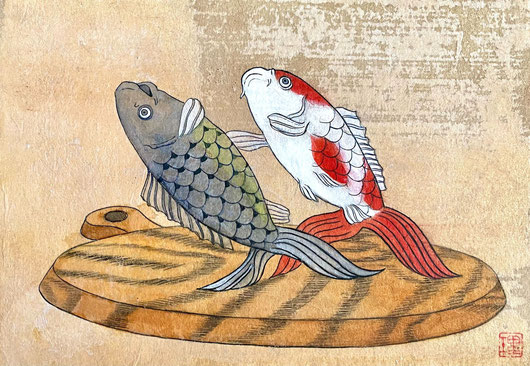
The Japanese proverb “Manaita no Koi” (carp on a cutting board), describes a situation in which one has no choice but to leave his fate to others. Here, the Koi carps, both in the same predicament, have a sumo match on a cutting board. Even if their fate is left to others, the painting depicts the small but desperate fighting spirit that the carps show for a fleeting moment, showing the true nature of living things.
This art poses deep questions as if it were describing ourselves in society, and yet they do so with a sense of humor. The gap between the serious and humorous side is what makes the painting more powerful in getting to the essence of things.
The sense of humor is what makes Rie Saito’s paintings unique. Her straightforward style may be the breakthrough needed to open up the way to a new era in this age of turmoil.
The Red and White Nishikigoi wrestle each other, with one bracing his mouth saying “Un” looking confident, and the other falling backwards while shouting “Ahhh~!”
The Japanese saying “A-Un” conveys the beginning and the end of all things, and is also depicted in the Kongo-Rikishi statue and the painting of Wind God and Thunder God. One can’t help but have high hopes for the artist, who draws sophisticated contemporary pieces incorporating traditional expressions.
(description by FFD)
Details of Rie Saito’s exhibition
Coming soon….
